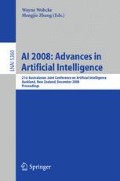Abstract
In this paper the notion of a partial-order plan is extended to task-hierarchies. We introduce the concept of a partial-order task-hierarchy that decomposes a problem using multi-tasking actions. We go further and show how a problem can be automatically decomposed into a partial-order task-hierarchy, and solved using hierarchical reinforcement learning. The problem structure determines the reduction in memory requirements and learning time.
Access this chapter
Tax calculation will be finalised at checkout
Purchases are for personal use only
Preview
Unable to display preview. Download preview PDF.
References
Russell, S., Norvig, P.: Artificial Intelligence: A Modern Approach. Prentice Hall, Upper Saddle River (1995)
Polya, G.: How to Solve It: A New Aspect of Mathematical Model. Princeton University Press, Princeton (1945)
Turchin, V.F.: The Phenomenon of Science. Columbia University Press (1977)
Simon, H.A.: The Sciences of the Artificial, 3rd edn. MIT Press, Cambridge (1996)
Barto, A., Mahadevan, S.: Recent advances in hiearchical reinforcement learning. Special Issue on Reinforcement Learning, Discrete Event Systems Journal 13, 41–77 (2003)
Dietterich, T.G.: Hierarchical reinforcement learning with the MAXQ value function decomposition. Journal of Artificial Intelligence Research 13, 227–303 (2000)
Thrun, S., Schwartz, A.: Finding structure in reinforcement learning. In: Tesauro, G., Touretzky, D., Leen, T. (eds.) Advances in Neural Information Processing Systems (NIPS), vol. 7. MIT Press, Cambridge (1995)
Digney, B.L.: Emergent hiearchical control structures: Learning reactive hierarchical relationships in reinforcement environments. In: From Animals to Animats 4: Proceedings of the fourth international conference on simulation of adaptive behaviour, pp. 363–372 (1996)
McGovern, A., Sutton, R.S.: Macro-actions in reinforcement learning: An empirical analysis. Amherst technical report 98-70, University of Massachusetts (1998)
Şimşek, O., Barto, A.G.: Using relative novelty to identify useful temporal abstractions in reinforcement learning. In: Proceedings of theTwenty-First International Conference on Machine Learning, ICML 2004 (2004)
Hengst, B.: Discovering hierarchy in reinforcement learning with HEXQ. In: Sammut, C., Hoffmann, A. (eds.) Proceedings of the Nineteenth International Conference on Machine Learning, pp. 243–250. Morgan Kaufmann, San Francisco (2002)
Sutton, R.S., Barto, A.G.: Reinforcement Learning: An Introduction. MIT Press, Cambridge (1998)
Harel, D.: Statecharts: A visual formalism for complex systems. Science of Computer Programming 8, 231–274 (1987)
Humphrys, M.: Action selection methods using reinforcement learning. In: Maes, P., Mataric, M., Meyer, J.A., Pollack, J., Wilson, S.W. (eds.) From Animals to Animats 4: Proceedings of the Fourth International Conference on Simulation of Adaptive Behavior, pp. 135–144. MIT Press, Bradford Books (1996)
Karlsson, J.: Learning to Solve Multiple Goals. PhD thesis, University of Rochester (1997)
Russell, S., Zimdars, A.: Q-decomposition for reinforcement learning agents. In: Proc. ICML 2003, Washington, DC (2003)
Rohanimanesh, K., Mahadevan, S.: Coarticulation: an approach for generating concurrent plans in markov decision processes. In: ICML 2005: Proceedings of the 22nd international conference on Machine learning, pp. 720–727. ACM Press, New York (2005)
Author information
Authors and Affiliations
Editor information
Editors and Affiliations
Rights and permissions
Copyright information
© 2008 Springer-Verlag Berlin Heidelberg
About this paper
Cite this paper
Hengst, B. (2008). Partial Order Hierarchical Reinforcement Learning. In: Wobcke, W., Zhang, M. (eds) AI 2008: Advances in Artificial Intelligence. AI 2008. Lecture Notes in Computer Science(), vol 5360. Springer, Berlin, Heidelberg. https://doi.org/10.1007/978-3-540-89378-3_14
Download citation
DOI: https://doi.org/10.1007/978-3-540-89378-3_14
Publisher Name: Springer, Berlin, Heidelberg
Print ISBN: 978-3-540-89377-6
Online ISBN: 978-3-540-89378-3
eBook Packages: Computer ScienceComputer Science (R0)

